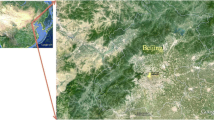Abstract
An extensive visibility monitoring was carried out simultaneously in the urban area of Gwangju and the rural area of Anmyon, Korea. This study examines patterns of visibility impairment and haze-forming pollutant concentrations on both sites resulting from natural and anthropogenic sources of gases and particles. Optical visibility measurements by a transmissometer, a nephelometer and an aethalometer provide aerosol light extinction, scattering, and absorption coefficients for both sites. In order to investigate the physico-chemical characteristics of atmospheric aerosols, aerosol samples were collected by various aerosol samplers at GJVMS (Gwangju Visibility Monitoring Station) and at KGAWO (Korea Global Atmosphere Watch Observatory), respectively. In addition, haze characteristics causing visibility impairment at those two sites were analyzed to obtain source contributions by regionally transported aerosols using grid analysis and display system (GrADS) from NECP reanalysis data. During the intensive monitoring period, ammonium sulfate was dominantly responsible for the fine particle mass loading at GJVMS, whereas organic carbon was the largest contributor at KGAWO. Light scattering by particles accounted for 52.8 to 81.3% of the range at the urban site, GJVMS and for 72.1 to 94.2% of the range at the rural site, KGAWO. Light absorption by the EC and NO2 was between 14.5 and 34.8% at GJVMS, which was higher than the observed 1.1 ∼ 6.8% at KGAWO, respectively. Light scattering by aerosol was higher in the rural area than in the urban area. And organic carbon concentration was observed to be significantly higher than the concentration of elemental carbon at KGAWO. These haze-forming carbonaceous particles originate from anthropogenic pollutants at the urban atmosphere but they can be produced by natural environments such as marine and forest at the rural atmosphere.
Similar content being viewed by others
References
Baik, N. J., Kim, Y. P., & Moon, K. C. (1996). Visibility study in Seoul, 1993. Atmospheric Environment, 30, 2319–2328.
Barthelmie, R. J., & Pryor, S. C. (1998). Implications of ammonia emissions for fine aerosol formation and visibility impairment - A case study from the Lower Fraser Valley, British Columbia. Atmospheric Environment, 32, 345–352.
Chan, Y. C., Simpson, R. W., Motainsh, G. H., Vowles, P. D., Cohen, D. D., & Bailey, G. H. (1999). Source apportionment of visibility degradation problems in Brisbane (Australia) using the multiple linear regression techniques. Atmospheric Environment, 33, 3237–3250.
Dzubay, T. G., Stevens, R. K., Lewis, C. W., Hern, D. H., Courtney, W. J., Tesch, J. W., et al. (1982). Visibility and aerosol composition in Houston, Texas. Environmental Science Technology, 16, 514–525.
Eldred, R. A., & Cahill, T. A. (1994). Trends in elemental concentrations of fine particles at remote sites in the United States. Atmospheric Environment, 28, 1009–1019.
Friedlander, S. K. (1977). Smoke, dust and haze. New York: Wiley.
Green, M. C., Pai P., Ashbaugh, L., & Farber, R. J. (2000). Evaluation of wind fields used in Grand Canyon visibility transport commission analyses. Air & Waste Management Association, 50, 809–817.
Hand, J. L., Ames, R. B., Kreidenweis, S. M., Day, D. E., & Malm, W. C. (2000). Estimates of particle hygroscopicity during the Southeastern Aerosol and Visibility Study. Air & Waste Management Association, 50, 677–685.
IMPROVE (1993). Spatial and temporal pattern and the chemical composition of the haze in the United States.
Kim, K. W., Kim, Y. J., & Oh, S. J. (2001). Visibility Impairment during Yellow Sand Periods in the Urban Atmosphere of Kwangju, Korea. Atmospheric Environment, 35, 5157–5167.
Malm, W. C., Molenar, J. V., Eldred, R. A., & Sisler, J. F. (1996). Examining the relationship among atmospheric aerosols and light scattering and extinction in Grand Canyon area. Journal of Geophysical Research, 101, 19251–19265.
Mathai, C. V., Watson, J. G., Rogers, J. F., Chow, J. C., Tombach, I., Zwicker, J. O., et al. (1990). Intercomparison of ambient aerosol samplers used in Western visibility and air quality studies. Environmental Science Technology, 24, 1090–1099.
Mazurek, M. A., & Cass, G. R. (1991). Biological Input to visibility-reducing aerosol particles in the remote arid southwestern United States. Environmental Science Technology, 25, 684–694.
National Research Council (1993). Protecting visibility in national parks and wilderness areas. Washington: National Academy Press.
Rasmussen, R. A., & Went, F. W. (1965). Volatile organic material of plants origin in the atmosphere. Proceedings of the National Academy of Sciences, 53, 215–220.
Seinfeld, J. H., & Pandis, S. N. (1998). Atmospheric chemistry and physics. New York: Wiley.
Tanner, R. L., & Schorran, D. E. (1995). Measurements of gaseous peroxides near the Grand Canyon – implication for summertime visibility impairment from aqueous-phase secondary sulfate formation. Atmospheric Environment, 29, 1113–1122.
Tsai, Y. I., & Cheng, M. T. (1999). Visibility and aerosol chemical compositions near the coastal area in Central Taiwan. The Science of the Total Environment, 231, 37–51.
Vinzani, P. G., & Lamb, P. J. (1985). Temporal and visibility variations in the Illinois vicinity during 1949–80. American Meteorological Society, 24, 435–451.
Waggoner, A. P., Weiss, R. E., Ahlquist, N. C., Covert, D. S., Will, S., & Charlson, R. J. (1981). Optical characteristics of atmospheric aerosol. Atmospheric Environment, 15A, 1891–1909.
Went, F. W. (1955). Air pollution. Scientific American, May, pp. 63–72.
Yanhong, T., Naoki, K., Akio, F., & Awang M. (1996). Light reduction by regional haze and its effect on simulated leaf photosynthesis in a tropical forest of Malaysia. Forest Ecology and Management, 89, 205–211.
Author information
Authors and Affiliations
Corresponding author
Rights and permissions
About this article
Cite this article
Kim, K.W., Kim, Y.J. & Bang, S.Y. Summer time haze characteristics of the urban atmosphere of Gwangju and the rural atmosphere of Anmyon, Korea. Environ Monit Assess 141, 189–199 (2008). https://doi.org/10.1007/s10661-007-9887-8
Received:
Accepted:
Published:
Issue Date:
DOI: https://doi.org/10.1007/s10661-007-9887-8



